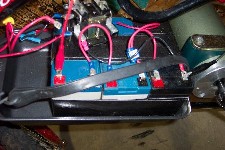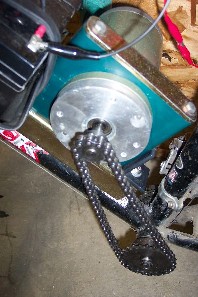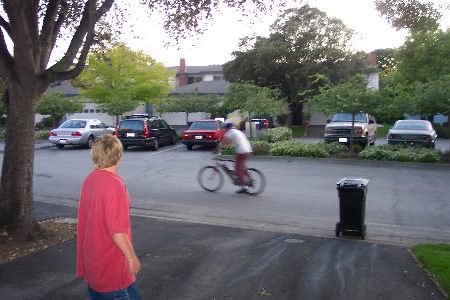There is no point to this project. There is nothing better about this set-up than what you can
just buy online for a couple hundred bucks. One of those hub mounted motor set-ups is much
faster and better built than this piece of crap. But this is the piece of crap that I made.
Most of the parts for this project I had laying around or found in the dumpster.
Bike
My old mountain bike I bought at cardinal bike shop in Stanford CA about 6 years ago. Rear tire has no tread and goes flat often. Rear bearing assembly also very wobbly and not all that safe. I hardly ride this bike any more because I got a road bike that actually works.

Batteries
The batteries for this bike are 12 VDC lead-acid cells. I got them out of a construction dumpster
near work in Palo Alto. I think they came from battery-backed up emergency lighting in EXIT signs. I brought home
something like 7 of them of approximately the same size. I charged them all individually and found 4
seemed to hold a decent charge. I hooked up the 4 in series since my motor had a 50VDC rating. I
mounted the batteries to the frame of the bike by first bolting a piece of unistrut to the bike.
Then I mounted a baking pan to the strut channel and bungeed the batteries to the pan. After
a few rides on the bike one of them started spewing acid/water vapor so now I only use 3 of them.
Motor
I'm using the Ametec DC motor I was previously using on the Bike Generator Page. Rating is 50VDC, don't have the specs for the torque or current maximums. It is 6" in diameter and has a smooth 1/2" shaft output. I mounted the motor to the strut channel with a standard 6" anti-vibration pipe clamp from McMaster.

Power Control
This is where the 'no-frills' really kicks in. At first I just hooked up a high (I thought) capacity momentary
switch between the batteries and the motor; the switch was mounted on the handlebar accessible with my
left thumb. First time I rode the bike, the switch melted closed and I had to yank out the power connector
to the battery to stop. Then I replaced the burned-out thumb switch and wired the new switch to the
biggest DC contactor I could find in my box. Rated for 30 amps, with 4 lead acid batteries in there
the current would arc across the contacts when I released the button and keep the motor moving slowly.
But after one of the batteries burned up, the contactor seemed to work fine with the reduced power.
Power Transmission
To drive the rear wheel with the motor required the most work on my part. I purchased some #30 roller chain and a couple of 1/2" bore sprockets; the smallest and largest they had at Surplus Center because I knew I needed a high gear ratio for that motor. I mounted the small sprocket on the motor; that was the easy part. For the drive shaft I had to pull the cranks off the bike and grind down the square shaft on the bike and make it round in order for the sprocket to fit. After this I found that the gear ratio was still not high enough; I didn't have enough torque. So I pulled the 5" bike sprocket off the other side of the drive shaft and replaced it with a 1" sprocket. Only problem is that bike chain is 1/2" pitch but very narrow width. I couldn't find any sprockets with this pitch/width with a standard 1/2" bore so I purchased a #40 sprocket (1/2" pitch but 3/8" wide) and ground the width down to match the bike chain. This seemed to do the trick and now there was enough torque and I could still use 6 out of the 7 gears on the rear tire with the standard derailleur.

Comfort Features
Since the pedals and cranks are gone, there is no place to put your feet. At first this was no big deal.
But then after a couple times of riding and all the shock going right up my back, my back started to hurt
at night. I then added a couple of foot-pegs (more strut channel) to the rear tire bolts. They get loose
sometimes when you stand on them; a welded assembly would be much better.
Summary
Only 1 kid was injured when his shorts got caught in the roller chain. So far no fingers amputated on the razor sharp sprockets spinning 500 RPM. Bike goes maybe 15 MPH on flats with me on it, 20 downhill and 5 uphill. I took it off-roading on dirt trial behind my house; still could use some work on those 'comfort features'.
The author assumes no liability for any incidental, consequential or other liability from the use of this information. All risks and damages, incidental or otherwise arising from the use or misuse of the information contained herein are entirely the responsibility of the user, have a nice day!
Page created: 08/28/07